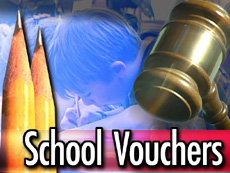 by Gary Jason –
by Gary Jason –
The failure of the American K-12 public school system has been obvious for decades. Some of us fossils can recall the public uproar that accompanied the release of the report “A Nation at Risk” back in 1987, documenting the mediocre at best, disastrously bad at worst performance of the nation’s public schools.
The public school special interest groups (the PSSIGs) — that is, public school administrators, education department professors, “labor studies” professors, textbook publishers, and most notoriously teachers unions and their members — managed to turn the outrage into support for jacking up spending.
Over the last quarter-century, we have nearly doubled our national per capita spending — we now outspend per capita for K-12 education every other nation on Earth but one. But our national student scores have remained flat, while internationally, we have dropped in ranking among developed nations from 14th during the 1970s down to 24th place today.
Fabulous news, however: our students still outscore the other kids of the world on — self-esteem!
Milton Friedman, the Nobel Prize-winning economist and public intellectual, devised an elegantly simple but profound solution to the problem: vouchers. Under the voucher concept, the money we the taxpayers give — yes, it is our money, not the PSSIGSs’ — to support public education is divided equally and goes directly to the children (through their parents), as opposed to being funneled through a giant rent-seeking machine. A brilliant, cut-to-the-chase concept: empower the users of a government-promoted service to pick the venue that best suits them, as opposed to what suits the providers of the service.
This fits well with Kantian ethics: it respects the dignity of autonomous individuals by letting them choose the path that leads to their greatest self-fulfillment.
Recent studies confirm consequentially what reasoning suggests logically. For example, a meta-study by the superb social scientist, Greg Forster (“A Win-Win Solution: the Empirical Evidence on School Vouchers”), reviews the literature on voucher programs, and it is quite positive.
He notes that of the ten “gold standard” studies of vouchers — that is, studies that look at the performance of kids who won the lottery to go to voucher schools versus those who entered the lottery but lost (so had to attend public schools instead) — nine show statistically significant gains in academic performance, and the one exception did show gains, just not at the level of statistical significance. By comparing students who got the vouchers with those who tried but didn’t get them, these studies effectively rule out other possible explanations for the academic gains, such as parental or student ambition.
Forster also reports that of the 19 empirical studies of the impact voucher schools have on the surrounding public schools, 18 confirm what one would expect a priori, viz., that competition from the voucher schools would force the public ones to improve their services. The remaining study shows no impact — but no harm, either.
Another study by Matthew Carr (“The Impact of Ohio’s EdChoice on Traditional Public School Performance”) provides yet more evidence of the validity of the voucher concept.
Carr researched the Ohio voucher program, called the Educational Choice Scholarship Program (“EdChoice”) and passed by the legislature there in 2005. EdChoice provides vouchers to a small number of public school students. EdChoice was fiercely opposed by Ohio’s PSSIGs then, and current Republican Governor Kasich is facing even fiercer PSSIG resistance now as he struggles to quadruple the number of vouchers available to students in failing public schools.
Carr’s study focuses on the crucial claim that voucher schools make public schools improve their quality of service through the force of competition (what he terms “the voucher threat”). Carr found that the public schools facing the voucher threat showed statistically significant gains in reading compared with those who didn’t.
Interestingly, the gains are most concentrated in the “tails of the Bell-shaped curve” — that is, the most advanced and least advanced students. As he puts it, this suggests that the public schools facing voucher competition put their focus on improving their services to the two groups they view as most likely to flee to private schools.
Neither Forster nor Carr reviews the studies done in other countries — such as Denmark; New Zealand; Sweden; and Quebec, Canada — that have national voucher programs. But those studies show that vouchers work to improve student outcomes, and that teachers like the results just as the parents do.
Even more exciting is the recent work by researchers investigating the effects of voucher programs on such non-academic but still vitally important phenomena as graduation rates and rates of campus violence. Here the results are even more dramatic.
The 2010 study of the D.C. voucher program done by the U.S. Department of Education — a study that President Obama shamefully suppressed while he killed the D.C. voucher system (even as he was finding the best private school for his own privileged children) — shows that the students who went to voucher schools had a 21% higher graduation rate than students who applied for vouchers but lost the lottery (91% versus 70%).
A similar study of the Milwaukee voucher program showed an 8% higher rate of graduation among voucher students than among the voucher applicants who went to public school (77% versus 69%).
And studies have shown that the voucher schools have lower rates of violence.
As states continue to struggle with their budgets, in the face of ever-higher expenses for public services, the choice of increasing student outcomes by moving to vouchers is becoming more and more of a no-brainer — which is why during the last year, several states adopted or expanded voucher programs.
HT: American Thinker
